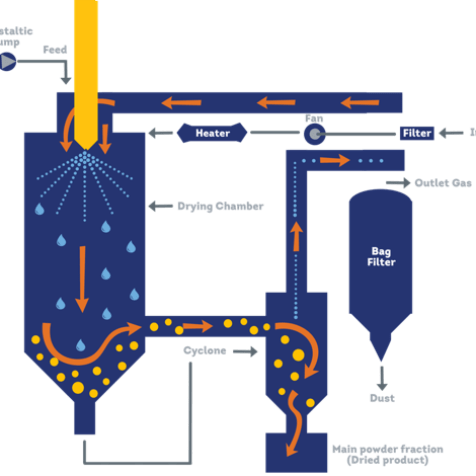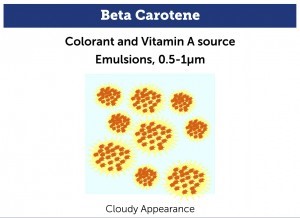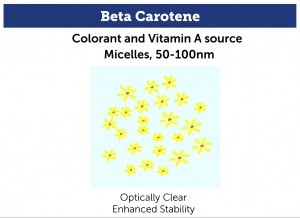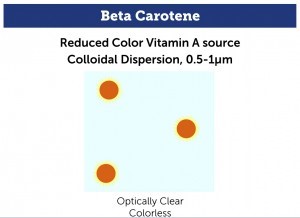Colloidal Dispersions
A good example of innovation in spray drying is our BetaClear™ beta-carotene. The illustration above shows a colloidal dispersion. When spray-dried, this colloidal dispersion will result in a dramatically different appearance in the finished product. There will be significantly less color contribution.
The colloidal dispersion almost tricks the eye in a way because it is light scattering.
What is a typical colloidal dispersion?
- Single-particle
- Light scattering
In the picture of the three bottles, each contains 25% of the daily value (DV) for vitamin A.
If dissolved into solution the spray dried colloidal dispersion would be similar to the center bottle. The solution would be clear and there would be minimal color contribution.
Applications for BetaClear™ include beverages, powder blends, and tablets.
Spray Drying Process in the Food and Supplement Industries
A growing number of consumer products are being fortified to help deliver essential vitamins and minerals to the end-user. Companies must determine the optimal way to deliver the recommended daily allowance (RDA) for that nutrient.
Premixes are one of the ways that companies like Glanbia are able to deliver the nutrient profile a consumer desires. Since many functional food ingredients can compose a product, processing technology must be looked at as well.
Typically, blending is utilized to make a premix, but other alternatives—spray drying, agglomeration, encapsulation, and roll compaction—also exist and can be used to create a homogenous premix blend. The spray drying process takes a liquid slurry and, under a temperature differential, removes the moisture giving a dried powder.
Factors Affecting Spray Drying
Spray Drying Parameters
There are several spray drying parameters that must be considered when selecting the optimal method to produce your dry powder.
Determine product moisture and particle size requirement as these can impact atomizer choice. For example, an atomizer wheel will give you a wider distribution of particle size while a nozzle will give you narrower distribution.
Selecting the right atomizer can also impact your product color as particle size and color are intertwined. Furthermore, if a nozzle is chosen, whether the nozzle is being used as part of a co-current flow or counter-current flow is another variable to consider as residence time in the dryer and particle size of the powder are impacted.
Another factor is the order of addition. Order of addition of raw materials can impact the viability of the emulsion or solution to be spray dried. Slurry temperature can also impact the viscosity of the material to be pumped. These are just some of the basic variables to look at when evaluating spray drying as a means to produce your powder.





